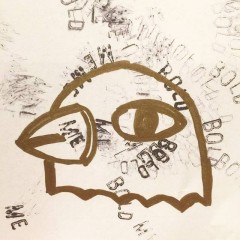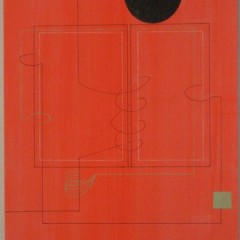On the way to hearing Ingrid Schaffner’s talk about collage at Penn the other week (a very excellent talk), I stopped at Penn’s Fox Gallery (basement of Logan Hall) to see “Points of Departure: Inner and Outer Journeys in Contemporary Art”, an exhibit sponsored by the Penn Humanities Forum on travel.
The show is huge, with some 53 artists and more than 60 works and because the basement gallery is divided into four modest-sized interconnected chambers with a distinct rabbit warren feel, it triggered my claustrophobia. My point of departure was to stay a tiny time, shoot some photos and get back to the fresh air.
That said, there are many good works in the show. And the theme is so loosely construed — any possible metaphorical reference to travel, points and journeys is in there — the show is broad, and, actually seems to reflect something that in this day and age should not be a surprise: It reflects the concept of movement through time and space although not the the geography of place. However, the psychology of place or better yet the psychology of displacement is everywhere. The biggest evocation in the show is a yearning for place and a kind of quest to find one that works for you, a quest perhaps fated to failure.
There are maps depicted, as well as passports, suitcases, highways and trucks, clothing, what looks like a campfire and the stars — and yet every work is metaphorical and less “real” and less about the real than about a concept of something else. I read eco-disaster into the painting of the trucks on the highway; homelessness into the faux passports that are themselves take-away postcards; and anxiety for the earth in general in maps that are cut up and retrofitted into some new hybrid of a music record and a fancy dinner plate. This utterly forlorn ambiance — of a cosmic as well as earthly displacement — sits over the works no matter where they were made — and here in this show, there’s works from artists all over the globe: London, San Antonio, Zagreb, Oakland, Taipei, Philadelphia, New York and elsewhere.
Transience is also evoked in a big way, from the ephemeral materials used to the small, compact and packable (or disposable) quality of many of the works. A wall of fortune cookies, a rug of corrugated cardboard, a clothesline with hand-stitched clothing clipped to it, postcards dangling by thread in the air: It all has the feel of a tent show that could fold up and disappear into the wilderness to re-appear again someplace else. Ghostly, I guess, is what I’d call it.
I’m back-loading the photos as an echo of a travel slide show. Here’s what stood out as objects that delighted and provoked my imagination:

James Thurman,Tectonic Plate 06-0725B, 2006. Recycled atlas, epoxy resin lamination, lathe-turned. 2.125×8.125x.75″
James Thurman’s Tectonic Plate is a complete delight. Geological plate via record via dinner plate, all produced through the canny gluing together of maps. Terrifically reverberant and lovely.
There’s lovely drawing on the hand-made clothing by Ya-Chu Kang. [Ed. note: The post originally speculated that the work was by Scot Andresen. That was a mistake. Apologies for the mis-attribution.]
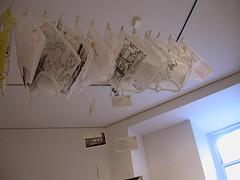
Ya-Chu Kang, Taiwan artist, made this great installation.
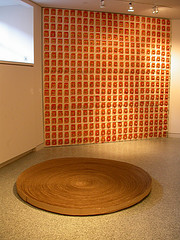
Caroline Santa, Wun Ting Wendy Tai, Santa–Black Hole, 2006, corrugated cardboard, 6×6′ (floor piece) and Tai — Totem-Object, 2006, fortune cookies, joss paper, cardboard, glue, 117×120″ (wall)
The wall of fortune cookies and the cardboard rug are similar to objects I’ve seen before. The ideas they evoke — disposability; cross-cultural meaning; homelessness — are big issues in the world and many young artists making work about those issues.
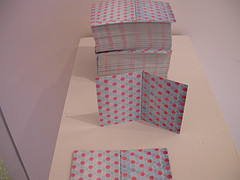
Ben Colebrook, Passport/Postcard, 2006. 500 postcards
Ben Colebrook’s passport project evokes many things — from Ellis Island to faux passport production to the disappeared.

Steven Dufala and Billy Blaise Dufala (foreground), Toilet Tricycle No. 4, 2005, steel, porcelain, bike parts, 3x3x4′ See the picture big to get a sense of the room’s space.
There’s not much humor in the show, and so the Dufala’s humorous Toilet Tricycle is a complete surprise–and delight. There’s an anarchistic impulse at work in this piece that seems to take the world as it is, poke a little fun at it, and keep on truckin. It’s a marvelous bit of uplift in a relentlessly downbeat show.

Diane Meyer, Sleeper Car Installation, Cards, 2004. lightjet print, 16×24″
Diane Meyer’s photograph of a stack of cards inside a window of what may be a train (sleeper car?) evoked in my mind Mary Ellen Mark‘s family living in a car. The idea of a vehicle as your home and time passing within it is poignant and imbues Meyer’s photo with a sense of children growing up trapped in situations that will perhaps snuff the fun out of them in the end.

Lisa Kereszi, I Love NY, outside Almaty, Kazakhstan, 2005, chromogenic print, 11×14″
Lisa Kereszi’s photo of a man on a horse on a pine-covered mountain trail is such an icon of a travel photo that it could represent anyone. To me it especially evokes America’s grand western parks and American tourists, but that is just my geo-centrism coming out. Kazakhstan is the locale of the shot and the horse and rider are presumably Kazakhstani. So, not only is Kazakhstan like Colorado but the I Love NY t-shirt — seen all over America — probably came to Kazakhstan (as well as to America) from a factory in China. Every place is unique but not it would appear.
The show, which is up to Feb. 23, was organized by ICA’s Naomi Beckwith, artist Shayna McConville from Penn’s School of Design, and Liliana Milkova, a Ph.D. candidate in the Art History department at Penn. More photos at flickr.


